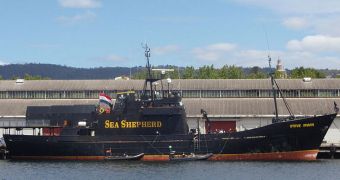The Sea Shepherd Conservation Society (SSCS) ship Steve Irwin has just broken off its trace of the Japanese whaling fleet in the Southern Ocean, and is currently set on a course for Wellington, New Zealand. The vessel has little fuel left, but will return to Antarctica soon.
Despite being on top of things in the Southern Ocean Whale Sanctuary, Sea Shepherd is forced to send the Steve Irwin to port, because otherwise it risks losing it. The ship would be of no use if it remained stuck beneath the ice masses.
But the whaling fleet will not be off the hook now that this ship is gone. The Bob Barker and the high-tech trimaran Gojira are now giving chase to the four Japanese whaling vessels, which are conducting their activities illegally in the Whale Sanctuary.
“We have run our fuel levels down to the point that we have no choice but to disengage,” says SSCS Captain Paul Watson, who is based on the Steve Irwin. He adds that the Gojira is currently returning from Hobart, Australia, where its captain replaced a damaged fuel pump.
Until the Sea Shepherd fleet is returned to its full potential, it will be the job of the Bob Barker to keep the Japanese whaling fleet in check, and prevent it from killing any more whale in the Sanctuary.
“Our continuous disruption, the constant fleeing of the factory ship, and the fact that two of three harpoon vessels have been taken off from whaling duties to tail Sea Shepherd for a month have significantly damaged the ability of the Japanese whaling fleet to conduct their operations down here in the Sanctuary,” says the captain of the Bob Barker, Alex Cornelissen.
“We will hound them until the end of the season. This whale sanctuary must be defended from these greedy poachers,” the SSCS official goes on to add.
“I am confident that the crews of the Bob Barker and the Gojira can keep the pressure on the whalers while we refuel and resupply,” Captain Watson says from aboard the Steve Irwin.
“I’ve got two excellent captains and two incredibly passionate crews on those two vessels. The whales will remain in good hands while we are gone,” he explains.
At this point, it is estimate that the Steve Irwin will be out of the chase for a little more than two weeks. The trip to New Zealand is expected to take about seven days in both direction. Refueling and port maneuvers will last for another two days.
SSCS hopes to have the ship back in pursuit of the Japanese whalers by no later than mid-February. “No matter where they go, we will follow them, and we will be relentless in our pursuit,” Watson says.
“It is a vast ocean down here fraught with dangers from weather and ice and with no recourse for assistance, if needed. We recognize these dangers and we recognize that this is a difficult campaign against a ruthless opposition,” he adds.
“We have no alternative but to do all that we can to save as many whales as we can and to defend what is designated by law as a sanctuary for whales,” he concludes.

 14 DAY TRIAL //
14 DAY TRIAL //